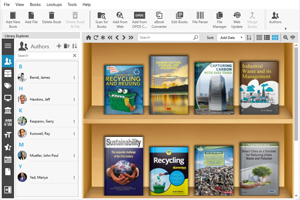4 books on Glass Recycling [PDF]
Updated: February 08, 2024 | 24 |
Books on Glass Recycling are essential resources for startups dedicated to advancing sustainable glass recycling technologies and promoting environmental conservation. These references offer a comprehensive foundation, covering various aspects of glass recycling processes, collection methods, and material recovery. They delve into advanced techniques such as closed-loop recycling, glass-to-glass recycling, and sustainable glass product design, emphasizing the importance of conserving resources, reducing energy consumption, and minimizing the environmental impact of glass waste. Moreover, these books often include practical examples, case studies, and best practices, enabling startups to navigate the complexities of glass recycling projects and adapt these solutions to real-world applications.
1. Projects with Recycling and Reusing
2014 by Louise Spilsbury

In "Projects with Recycling and Reusing," readers will embark on an eco-friendly crafting journey using readily available household supplies while simultaneously nurturing their environmental awareness. This book guides readers in crafting imaginative creations such as a bird feeder crafted from a milk carton, a cloth pocket pouch, musical shakers fashioned from plastic bottles, and an array of other inventive projects. It offers a seamless blend of eco-consciousness and creativity. In addition to introducing exciting craft projects, the book imparts vital insights into conservation and waste reduction through vibrant callouts and accessible text, all complemented by captivating photographs. Crafting and caring for the environment have never been more harmoniously intertwined!
Download PDF
2. Recycling Reconsidered: The Present Failure and Future Promise of Environmental Action in the United States
2013 by Samantha Macbride

The widespread adoption and popularity of recycling have often diverted attention away from the substantial environmental toll of manufacturing the products we consume and eventually discard. While recycling is lauded as an environmental triumph, with evident success in municipal practices, a thriving private recycling sector, and strong public support and participation, its core objectives of saving the planet, conserving resources, and fostering a green economy remain unfulfilled. Samantha MacBride underscores in this book that, despite the fact that more Americans recycle than vote, the majority of solid waste is still either incinerated or buried. MacBride contends that since the inception of the recycling movement in 1970, manufacturers of disposable products have effectively thwarted the implementation of more demanding yet significantly more effective sustainable waste policies. Present-day recycling often creates an illusion of progress while enabling industries to perpetuate the status quo and shift responsibility onto consumers and local governments. MacBride presents a series of recycling case studies that provoke essential questions about whether our current waste management approaches are genuinely the most effective means to attain real sustainability and environmental justice. Her aim is not to discredit or dissuade recycling but to prompt us to contemplate a future beyond the current recycling paradigm.
Download PDF
3. Glass Waste
2004 by Kingston University (London, England)

This book is part of the Proceedings of a two-day International Conference orchestrated by the Concrete and Masonry Research Group within Kingston University's School of Engineering, which convened in September 2004. The conference delves into multifaceted topics encompassing the regulatory landscape, governmental policies, waste management strategies, processing techniques, recovery methods, supply networks, prospects for recycling, sustainable pathways, and the economic aspects of sustainability.
Download PDF
4. Recycling and Reuse of Glass Cullet
2001 by Ravindra K. Dhir, Mukesh C. Limbachiya, Thomas D. Dyer

Embracing sustainable practices has become an imperative, and optimizing the utilization of excess glass cullet is a pivotal aspect of this endeavor. The concrete construction sector offers a range of viable alternative applications for cullet, augmenting the value derived from this residual material. This book encapsulates the proceedings of an International Symposium orchestrated by the Concrete Technology Unit at the University of Dundee, uniting a consortium of foremost global experts in the realm of glass cullet recycling.
Download PDF
How to download PDF:
1. Install Google Books Downloader
2. Enter Book ID to the search box and press Enter
3. Click "Download Book" icon and select PDF*
* - note that for yellow books only preview pages are downloaded
1. Projects with Recycling and Reusing
2014 by Louise Spilsbury

In "Projects with Recycling and Reusing," readers will embark on an eco-friendly crafting journey using readily available household supplies while simultaneously nurturing their environmental awareness. This book guides readers in crafting imaginative creations such as a bird feeder crafted from a milk carton, a cloth pocket pouch, musical shakers fashioned from plastic bottles, and an array of other inventive projects. It offers a seamless blend of eco-consciousness and creativity. In addition to introducing exciting craft projects, the book imparts vital insights into conservation and waste reduction through vibrant callouts and accessible text, all complemented by captivating photographs. Crafting and caring for the environment have never been more harmoniously intertwined!
Download PDF
2. Recycling Reconsidered: The Present Failure and Future Promise of Environmental Action in the United States
2013 by Samantha Macbride

The widespread adoption and popularity of recycling have often diverted attention away from the substantial environmental toll of manufacturing the products we consume and eventually discard. While recycling is lauded as an environmental triumph, with evident success in municipal practices, a thriving private recycling sector, and strong public support and participation, its core objectives of saving the planet, conserving resources, and fostering a green economy remain unfulfilled. Samantha MacBride underscores in this book that, despite the fact that more Americans recycle than vote, the majority of solid waste is still either incinerated or buried. MacBride contends that since the inception of the recycling movement in 1970, manufacturers of disposable products have effectively thwarted the implementation of more demanding yet significantly more effective sustainable waste policies. Present-day recycling often creates an illusion of progress while enabling industries to perpetuate the status quo and shift responsibility onto consumers and local governments. MacBride presents a series of recycling case studies that provoke essential questions about whether our current waste management approaches are genuinely the most effective means to attain real sustainability and environmental justice. Her aim is not to discredit or dissuade recycling but to prompt us to contemplate a future beyond the current recycling paradigm.
Download PDF
3. Glass Waste
2004 by Kingston University (London, England)

This book is part of the Proceedings of a two-day International Conference orchestrated by the Concrete and Masonry Research Group within Kingston University's School of Engineering, which convened in September 2004. The conference delves into multifaceted topics encompassing the regulatory landscape, governmental policies, waste management strategies, processing techniques, recovery methods, supply networks, prospects for recycling, sustainable pathways, and the economic aspects of sustainability.
Download PDF
4. Recycling and Reuse of Glass Cullet
2001 by Ravindra K. Dhir, Mukesh C. Limbachiya, Thomas D. Dyer

Embracing sustainable practices has become an imperative, and optimizing the utilization of excess glass cullet is a pivotal aspect of this endeavor. The concrete construction sector offers a range of viable alternative applications for cullet, augmenting the value derived from this residual material. This book encapsulates the proceedings of an International Symposium orchestrated by the Concrete Technology Unit at the University of Dundee, uniting a consortium of foremost global experts in the realm of glass cullet recycling.
Download PDF
How to download PDF:
1. Install Google Books Downloader
2. Enter Book ID to the search box and press Enter
3. Click "Download Book" icon and select PDF*
* - note that for yellow books only preview pages are downloaded


